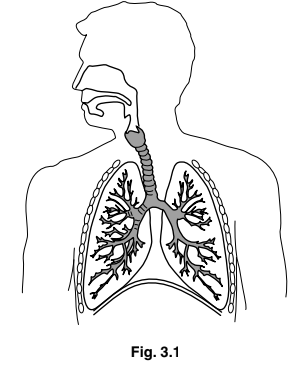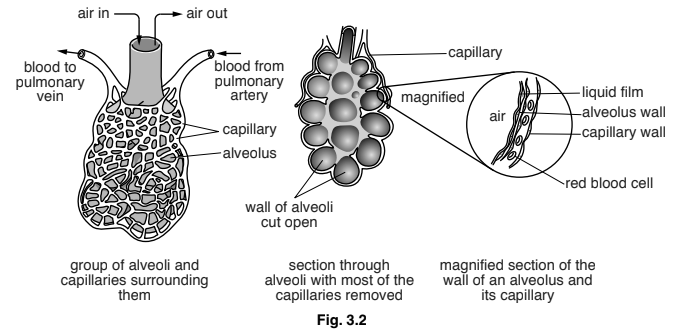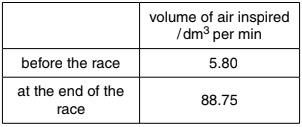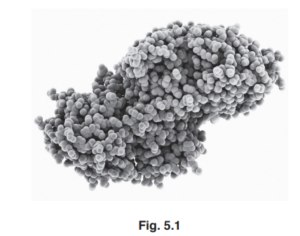Question
Question
Question
The terms eating and breathing are often wrongly stated as characteristics of living
organisms.
(a) Eating is often confused with nutrition.
Define the term nutrition.

(b) Breathing is often confused with respiration.
Define the term respiration.

Answer/Explanation
Ans:

Question
Fig. 3.1 shows the human respiratory system.

(a) On Fig. 3.1 use label lines to identify:
a bronchiole;
the larynx;
the trachea.
(b) Fig. 3.2 shows:
a group of alveoli and the capillaries surrounding them in a human lung;
a section through this group of alveoli with most of the capillaries removed;
a magnified section of part of the wall of an alveolus and its capillary.

Use Fig. 3.2 to describe three features of gas exchange surfaces in animals.
(c) In an investigation a student recorded the volume of air inspired in one minute. The measurement was taken while the student was resting and again when the student had run an 800 m race.
The results are shown in Table 3.1.
Table 3.1

(i) Calculate the increase in the volume of air inspired by the student at the end of the race.
(ii) State two changes that the body makes to increase the volume of air inspired.
(iii) Suggest one reason why the body needs more air during exercise.
Answer/Explanation
Ans:
(a) bronchiole ;
larynx ;
trachea ;
(b) large surface area (per volume) ;
thin/ small diffusion distance ;
moist/wet/liquid film ;
(alveolar) wall permeable ;
well ventilated/ diffusion gradient maintained ;
well supplied with capillaries / diffusion gradient maintained ;
(c) (i) 82.95(dm^{3} / min) ;
(ii) breaths more rapid /AW ;
breaths deeper / heavier /AW ;
(iii) more oxygen needed ;
more (cell) respiration carried out ;
more energy is required ;
more muscle contraction ;
Question
(a) (i) Alcohol can be made by the microorganism yeast.
State the balanced chemical equation for the production of alcohol by yeast.
………………………………………………………………………………………………………………………
[2]
Answer/Explanation
Ans:
C6H12O6 → 2C2H5OH + 2CO2 ;;
Question
(ii) Name the organ that breaks down alcohol in the human body.
………………………………………………………………………………………………………………………
[1]
Answer/Explanation
Ans:
liver ;
Question
(b) Fig. 5.1 shows a computer model of the enzyme alcohol dehydrogenase, which is the enzyme responsible for breaking down alcohol.

Enzymes have a specific three dimensional shape.
Explain why the shape of an enzyme is important.
…………………………………………………………………………………………………………………………………
…………………………………………………………………………………………………………………………………
…………………………………………………………………………………………………………………………………
…………………………………………………………………………………………………………………………………
…………………………………………………………………………………………………………………………………
…………………………………………………………………………………………………………………………………
…………………………………………………………………………………………………………………………………
[3]
Answer/Explanation
Ans:
correct ref to active site ;
enzyme must be complementary shape to, substrate / alcohol ;
to make enzyme – substrate complex / to allow substrate to bind to enzyme ;
ref to only fits one substrate / specific to one substrate ;
(c) Table 5.1 shows the enzyme activity of alcohol dehydrogenase at different temperatures.
Table 5.1
| temperature/ °C | enzyme activity /arbitrary units |
| 30 | 115 |
| 42 | 175 |
Question
(i) The information in Table 5.1 shows that an increase in temperature increases the activity
of alcohol dehydrogenase.
Explain why an increase in temperature causes an increase in enzyme activity.
………………………………………………………………………………………………………………………….
………………………………………………………………………………………………………………………….
………………………………………………………………………………………………………………………….
………………………………………………………………………………………………………………………….
………………………………………………………………………………………………………………………….
………………………………………………………………………………………………………………………….
………………………………………………………………………………………………………………………….
[3]
Answer/Explanation
Ans:
ncreased kinetic energy ;
molecules move faster ;
increased frequency of collisions ;
increased number of successful collisions ;
Question
(ii) State one factor, other than temperature, that affects enzyme activity.
………………………………………………………………………………………………………………………
[1]
Answer/Explanation
Ans:
pH ;
Question
(d) A gene is involved in the production of the enzyme alcohol dehydrogenase.
(i) Define the term gene.
………………………………………………………………………………………………………………………….
………………………………………………………………………………………………………………………….
………………………………………………………………………………………………………………………….
[2]
Answer/Explanation
Ans:
ength of DNA ;
that codes for a protein ;
Question
(ii) Describe the role of ribosomes in the synthesis of proteins such as enzymes.
………………………………………………………………………………………………………………………….
………………………………………………………………………………………………………………………….
………………………………………………………………………………………………………………………….
………………………………………………………………………………………………………………………….
…………………………………………………………………………………………………………………………
[2]
Answer/Explanation
Ans:
mRNA passes through ribosomes ;
ribosomes assemble amino acids into proteins ;
order of amino acids is determined by the sequence of bases in mRNA ;
AVP ;
Question
(a) Yeast can respire aerobically and anaerobically.
State the balanced chemical equation for aerobic respiration by yeast.
…………………………………………………………………………………………………………………………………
Answer/Explanation
Ans:
C6H12 O6 + 6O2 → ;
6H2O + 6CO2 ;
(b) When yeast respires anaerobically, ethanol is released.
Ethanol is a type of sustainable resource that can be produced from a wide range of crops.
It can be used as a biofuel.
Table 5.1 summarises some information about crops that are used to make biofuel.
Table 5.1
| crop | biofuel produced | energy yield /GJ per ha | optimum growth temperature/ °C | optimum annual rainfall range/mm |
| wheat | ethanol | 53–84 | 24 | 800-1200 |
| corn | ethanol | 63-76 | 18 | 360-1000 |
| sugar beet | ethanol | 110-122 | 18 | 360-1000 |
| sugar cane | ethanol | 110-140 | 28 | 800-1200 |
| oil palm | oil | 150-166 | 28 | 1100-2500 |
Question
(i) Uruguay has an average temperature range of 12°C to 24°C and an average annual
rainfall of 1000mm.
Suggest and explain which crop would be the most suitable crop to grow for producing
biofuel in Uruguay.
Use the information in Table 5.1 to justify your choice.
………………………………………………………………………………………………………………………….
………………………………………………………………………………………………………………………….
………………………………………………………………………………………………………………………….
………………………………………………………………………………………………………………………….
………………………………………………………………………………………………………………………….
………………………………………………………………………………………………………………………….
…………………………………………………………………………………………………………………………
Answer/Explanation
Ans:
sugar beet ;
(one of three crops that) falls with appropriate temperature range / ora ;
sugar beet / corn requirement for rainfall, is in the range ;
wheat requires more rainfall ;
corn / wheat, has a lower productivity / energy yield ;
appropriate use of data ;
Question
(ii) Sugar cane requires soil with high concentrations of nitrogen and potassium.
Describe how the lack of nitrate ions would affect the production of sugar cane.
………………………………………………………………………………………………………………………….
………………………………………………………………………………………………………………………….
………………………………………………………………………………………………………………………….
………………………………………………………………………………………………………………………….
………………………………………………………………………………………………………………………….
………………………………………………………………………………………………………………………….
………………………………………………………………………………………………………………………….
Answer/Explanation
Ans:
stunted / reduced / no, growth / yield ;
used to make amino acids / proteins ;
amino acids converted to proteins ;
named molecule containing nitrogen ;
Question
(iii) Researchers in Brazil are considering using microscopic algae that live in water to produce biofuels. They have found that algae can produce a maximum amount of energy of 200GJ per m2.
1m2 = 0.0001 ha
Convert the production of biofuel from algae into GJ per ha.
Space for working.
…………………………………… GJ per ha
Answer/Explanation
Ans:
200 ÷ 0.0001
2 000 000 ÷ 2 × 106 ;
Question
(iv) Suggest why people who are concerned about the environment want countries to produce more biofuel from algae rather than the crops listed in Table 5.1.
………………………………………………………………………………………………………………………….
………………………………………………………………………………………………………………………….
………………………………………………………………………………………………………………………….
………………………………………………………………………………………………………………………….
………………………………………………………………………………………………………………………….
………………………………………………………………………………………………………………………….
…………………………………………………………………………………………………………………………
Answer/Explanation
Ans:
less land required ;
crops can be used as food (rather than fuel) ;
less habitat destruction / less deforestation ;
less disruption to food chains / greater diversity maintained ;
comparison of algae yield with any crop from Table 5.1, with units ;
AVP ;
Question
Define the term sustainable development.
…………………………………………………………………………………………………………………………………
…………………………………………………………………………………………………………………………………
…………………………………………………………………………………………………………………………………
Answer/Explanation
Ans:
development that provides for the needs of an (increasing) human (population) ;
without harming the natural environment / ecosystems / habitat ;
